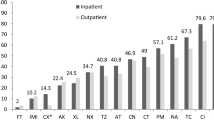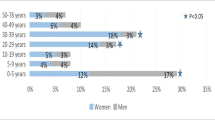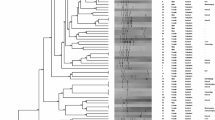Abstract
Uropathogenic Escherichia coli (UPEC) is the main cause of urinary tract infections; in recent years, its importance as a pathogen has increased due to the emergence of hypervirulent and multiresistant strains. In this study, 190 urinary isolates of E. coli were assigned into the seven phylogenetic groups A (11.1%), B1 (4.7%), B2 (46.8%), C (5.8%) D (25.3%) F (2.6%), and Clade I (2.1%), and various virulence genes were examined with polymerase chain reaction methods. All isolates had at least one virulence factor of the 9 analyzed fyuA (81.1%), fimH (96.8%), iutA (74.7%), ompT (66.8%), kpsMTII (66.8%), traT (58.9%), PAI (43.6%), PapAH (26.3%), and usp (3.2%). The results showed a direct relationship between the virulence factors and phylogenetic group A and B2. Further, virulence genetic profiles fimH, fyuA, ompT, traT, and kpsMTII correlated with the production of strong biofilm, multidrug resistance, and the production of moderate hemolysin. These results suggest that these strains may become reservoirs of genes that encode virulence factors, which could be transferred horizontally enhancing their genomic background and high possibility of acquiring new genetic information for possible dissemination. This study provides the first description of phylogroups in UPEC in the Colombian Caribbean and the association with virulence factor profile, antimicrobial susceptibility, and their possible role in the epidemiology in Colombia.
Similar content being viewed by others
References
Foxman B, Gillespie B, Koopman J, Zhang L, Palin K, Tallman P, Marrs F (2000) Risk factors for second urinary tract infection among college women. Am J Epidemiol 151(12):1194–1205. https://doi.org/10.1093/oxfordjournals.aje.a010170
Flores-Mireles A, Walker N, Caparon M, Hultgren J (2015) Urinary tract infections: epidemiology, mechanisms of infection and treatment options. Nat Rev Microbiol 13(5):269. https://doi.org/10.1038/nrmicro3432
Mokady D, Gophna U, Ron EZ (2005) Virulence factors of septicemic Escherichia coli strains. Int J Med Microbiol 295:455–462. https://doi.org/10.1016/j.ijmm.2005.07.007
Jauréguy F, Carbonnelle E, Bonacorsi S, Clec'h C, Casassus P, Bingen E, Lortholary O (2007) Host and bacterial determinants of initial severity and outcome of Escherichia coli sepsis. Clin Microbiol Infect 13:854–862. https://doi.org/10.1111/j.1469-0691.2007.01775.x
Soto S, Smithson A, Horcajada JP, Martinez JA, Mensa JP, Vila J (2006) Implication of biofilm formation in the persistence of urinary tract infection caused by uropathogenic Escherichia coli. Clin Microbiol Infect 12:1034–1036. https://doi.org/10.1111/j.1469-0691.2006.01543.x
Chaudhuri RR, Henderson IR (2012) The evolution of the Escherichia coli phylogeny. Infect Genet Evol 12:214–226. https://doi.org/10.1016/j.meegid.2012.01.005
Russo TA, Johnson JR (2000) Proposal for a new inclusive designation for extraintestinal pathogenic isolates of Escherichia coli: ExPEC. J Infect Dis 181:1753–1754. https://doi.org/10.1086/315418
Johnson JR, Johnston B, Clabots C, Kuskowski MA, Castanheira M (2010) Escherichia coli sequence type ST131 as the major cause of serious multidrug-resistant E. coli infections in the United States. Clin Infect Dis 51:286–294. https://doi.org/10.1086/653932
Van der Bij AK, Pitout JD (2012) The role of international travel in the worldwide spread of multiresistant Enterobacteriaceae. J Antimicrob Chemother 67:2090–2100. https://doi.org/10.1093/jac/dks214
Leal L, Cortés J, Arias G, Ovalle MV, Saavedra S, Buitrago G, Castro B (2013) Emergence of resistance to third generation cephalosporins by Enterobacteriaceae causing community-onset urinary tract infections in hospitals in Colombia. Enferm Infecc Microbiol Clin 31(5):298–303. https://doi.org/10.1016/j.eimc.2012.04.007
Martinez P, Garzón D, Mattar S (2012) CTX-M-producing Escherichia coli and Klebsiella pneumoniae isolated from community-acquired urinary tract infections in Valledupar, Colombia. Braz J Infect Dis 16(5):420–425. https://doi.org/10.1016/j.bjid.2012.05.001
Blanco M, Maya J, Correa A, Perenguez M, Muñoz S, Motoa G, Garzon M (2016) Prevalencia y factores de riesgo para infecciones del tracto urinario de inicio en la comunidad causadas por Escherichia coli productor de betalactamasas de espectro extendido en Colombia. Enferm Infecc Microbiol Clin 34(9):559–565. https://doi.org/10.1016/j.eimc.2015.11.017
Baldiris R, Teheran V, Vivas-Reyes R, Montes A, Arzuza O (2016) Anti-biofilm activity of ibuprofen and diclofenac against some biofilm producing Escherichia coli and Klebsiella pneumoniae uropathogens. Afr J Microbiol Res 10(40):1675–1684. https://doi.org/10.5897/AJMR2016.8039
Alviz A, Gamero K, Caraballo R, Gamero J (2018) Prevalencia de infección del tracto urinario, uropatógenos y perfil de susceptibilidad en un hospital de Cartagena, Colombia. Rev Fac Med 66(3):313–317. https://doi.org/10.15446/revfacmed.v66n3.62601
Correa J, Montes J, Dueñas C, Ramos Clason E (2018) Caracterización de las infecciones asociadas con la atención en salud en la unidad de cuidados intensivos de la Clínica Gestión Salud IPS durante el periodo 2015–2017. Doctoral dissertation, Universidad de Cartagena
Mahon C, Lehman D, Manuselis G (2015) Textbook of diagnostic microbiology, 5th edn. Saunders, Amsterdam, Philadelphia
MacFaddin JF (2003) Pruebas bioquímicas para la identificación de bacterias de importancia clínica, 3era edición. Ed. Méd. Panamericana, Buenos Aires, Argentina
Gómez-Duarte OG, Arzuza O, Urbina D, Bai J, Guerra J, Montes O, Castro GY (2010) Detection of Escherichia coli enteropathogens by multiplex polymerase chain reaction from children’s diarrheal stools in two Caribbean–Colombian cities. Foodborne Pathog Dis 7:199–206. https://doi.org/10.1089/fpd.2009.0355
Clermont O, Christenson JK, Denamur E, Gordon DM (2013) The Clermont Escherichia coli phylo-typing method revisited: improvement of specificity and detection of new phylo-groups. Environ Microbiol Rep 5:58–65. https://doi.org/10.1111/1758-2229.12019
Johnson JR, Stell AL (2000) Extended virulence genotypes of Escherichia coli strains from patients with urosepsis in relation to phylogeny and host compromise. J Infect Dis 181:261–272. https://doi.org/10.1086/315217
Nakano M, Yamamoto S, Terai A, Ogawa O, Makino SI, Hayashi H, Kurazono H (2001) Structural and sequence diversity of the pathogenicity island of uropathogenic Escherichia coli which encodes the USP protein. FEMS Microbiol Lett 205:71–76. https://doi.org/10.1111/j.1574-6968.2001.tb10927.x
Johnson JR, O’Bryan TT, Low DA, Ling G, Delavari P, Fasching C, Stell AL (2000) Evidence of commonality between canine and human extraintestinal pathogenic Escherichia coli strains that ExpresspapG allele III. Infect Immun 68:3327–3336. https://doi.org/10.1128/iai.68.6.3327-3336.2000
Johnson JR, Brown JJ, Carlino UB, Russo TA (1998) Colonization with and acquisition of uropathogenic Escherichia coli as revealed by polymerase chain reaction-based detection. J Infect Dis 177:1120–1124. https://doi.org/10.1086/517409
Freeman DJ, Falkiner FR, Keane CT (1989) New method for detecting slime production by coagulase negative staphylococci. J Clin Pathol 42:872–874. https://doi.org/10.1136/jcp.42.8.872
Bokranz W, Wang X, Tschäpe H, Römling U (2005) Expression of cellulose and curli fimbriae by Escherichia coli isolated from the gastrointestinal tract. J Med Microbiol 54:1171–1182. https://doi.org/10.1099/jmm.0.46064-0
O’toole GA, Kolter R (1998) Initiation of biofilm formation in Pseudomonas fluorescens WCS365 proceeds via multiple, convergent signalling pathways: a genetic analysis. Mol Microbiol 28:449–461. https://doi.org/10.1046/j.1365-2958.1998.00797.x
Stepanović S, Vuković D, Hola V, Bonaventura GD, Djukić S, Ćirković I, Ruzicka F (2007) Quantification of biofilm in microtiter plates: overview of testing conditions and practical recommendations for assessment of biofilm production by staphylococci. Apmis 115:891–899. https://doi.org/10.1111/j.1600-0463.2007.apm_630.x
Scheffer J, Konig W, Braun V (1988) Comparison of four hemolysin-producing organisms (Escherichia coli, Serratia marcescens, Aeromonas hydrophila, and Listeria monocytogenes) for release of inflammatory mediators from various cells. J Clin Microbiol 26:544–551. https://jcm.asm.org/content/26/3/544.long
Miranda-Estrada LI, Ruíz-Rosas M, Molina-López J, Parra-Rojas I, González-Villalobos E, Castro-Alarcón N (2017) Relationship between virulence factors, resistance to antibiotics and phylogenetic groups of uropathogenic Escherichia coli in two locations in Mexico. Enferm Infecc Microbiol Clin 35(7):426–433. https://doi.org/10.1016/j.eimce.2017.06.005
Weinstein MP, Clinical and laboratory standards institute (2017) In: Performance standards for antimicrobial susceptibility testing, 27th edn. Clinical and Laboratory Standards Institute, Wayne, PA, USA, p 296
Magiorakos AP, Srinivasan A, Carey RB, Carmeli Y, Falagas ME, Giske CG, Paterson DL (2012) Multidrug-resistant, extensively drug-resistant and pandrug-resistant bacteria: an international expert proposal for interim standard definitions for acquired resistance. Clin Microbiol Infect 18:268–281. https://doi.org/10.1111/j.1469-0691.2011.03570.x
Krumperman PH (1983) Multiple antibiotic resistance indexing of Escherichia coli to identify high-risk sources of fecal contamination of foods. Appl Environ Microbiol 46:165–170
Lezameta L, Gonzáles-Escalante E, Tamariz JH (2010) Comparación de cuatro métodos fenotípicos para la detección de beta-lactamasas de espectro extendido. Rev Med Expe Salud Publica 27:345–351
Conceição T, Brízio A, Duarte A, Lito LM, Cristino JM, Salgado MJ (2005) First description of CTX-M-15-producing Klebsiella pneumoniae in Portugal. Antimicrob Agents Chemother 49(1):477–478. https://doi.org/10.1128/AAC.49.1.477-478.2005
Sambrook J, Fritsch EF, Maniatis T (1989) Molecular cloning: a laboratory manual, 2nd edn. Cold Spring Harbor Laboratory Press, Cold Spring Harbor, New York, p 1546
Snedecor GWC, William G (1989) Statistical methods/george w. Snedecor and william g. Cochran (No. QA276. 12. S6313 1989)
Iranpour D, Hassanpour M, Ansari H, Tajbakhsh S, Khamisipour G, Najafi A (2015) Phylogenetic groups of Escherichia coli strains from patients with urinary tract infection in Iran based on the new Clermont phylotyping method. Biomed Res Int. https://doi.org/10.7883/yoken.JJID.2015.652
Spurbeck RR, Dinh PC, Walk ST, Stapleton AE, Hooton TM, Nolan LK, Mobley HL (2012) Escherichia coli isolates that carry vat, fyuA, chuA, and yfcV efficiently colonize the urinary tract. Infect Immun 80:4115–4122. https://doi.org/10.1128/IAI.00752-12
Sauer K (2003) The genomics and proteomics of biofilm formation. Gen Biol 4:219. https://doi.org/10.1186/gb-2003-4-6-219
Johnson J, Scheutz F, Ulleryd P, Kuskowski M, O’Bryan T, Sandberg T (2005) Phylogenetic and pathotypic comparison of concurrent urine and rectal Escherichia coli isolates from men with febrile urinary tract infection. J Clin Microbiol 43(8):3895–3900. https://doi.org/10.1128/JCM.43.8.3895-3900.2005
Johnson TJ, Nolan LK (2010) Pathogenomics of the virulence plasmids of Escherichia coli. Microbiol Mol Biol Rev 74:750–774. https://doi.org/10.1128/MMBR.00002-10
Millán Y, Hernández E, Millán B, Araque M (2014) Distribución de grupos filogenéticos y factores de virulencia en cepas de Escherichia coli uropatógena productora de β-lactamasa CTX-M-15 aisladas de pacientes de la comunidad en Mérida, Venezuela. Rev Arg Microbiol 46:175–181. https://doi.org/10.1016/S0325-7541(14)70069-0
Chen SL, Wu M, Henderson JP, Hooton TM, Hibbing ME, Hultgren SJ, Gordon JI (2013) Genomic diversity and fitness of E. coli strains recovered from the intestinal and urinary tracts of women with recurrent urinary tract infection. Sci Transl Med 5:184–197
Acknowledgements
Rosa Baldiris is grateful to the University of Cartagena (Cartagena, Colombia) for continuous support to her research group. Alfredo Montes thank the Administrative Department of Science, Technology, and Innovation Colciencias for its ‘Young researchers’ program. Yaleyvis Buelvas is grateful to the University of Sinú (Cartagena, Colombia) for continuous support to her research group. The authors would like to thank Dr. Sandra Perdomo for her important technical support, Dra María Cabarcas and Rafael Ruiz-Quintana for their important support in reviewing this paper, and Dra. Julia Pimienta for their important technical and clinical support.
Author information
Authors and Affiliations
Contributions
RB and AM conceived and designed the study; AM and YB performed the experiment; RB and AM carried out the experiment and theoretical part of this study; RB, AM, and YB wrote the first draft of the paper; RB and AM critically reviewed the paper.
Corresponding author
Ethics declarations
Conflict of interest
The authors declare that there is no conflict of interest.
Ethical Approval
This contribution was based on laboratory records and not medicals records. However, it was sent and approved from the Ethics Committee contemplated in Act No. 106-15-03-18, which conforms to the academic, technical, and administrative standards in health in Colombia according to resolution 008430 of 1993.
Additional information
Publisher's Note
Springer Nature remains neutral with regard to jurisdictional claims in published maps and institutional affiliations.
Rights and permissions
About this article
Cite this article
Baldiris-Avila, R., Montes-Robledo, A. & Buelvas-Montes, Y. Phylogenetic Classification, Biofilm-Forming Capacity, Virulence Factors, and Antimicrobial Resistance in Uropathogenic Escherichia coli (UPEC). Curr Microbiol 77, 3361–3370 (2020). https://doi.org/10.1007/s00284-020-02173-2
Received:
Accepted:
Published:
Issue Date:
DOI: https://doi.org/10.1007/s00284-020-02173-2




